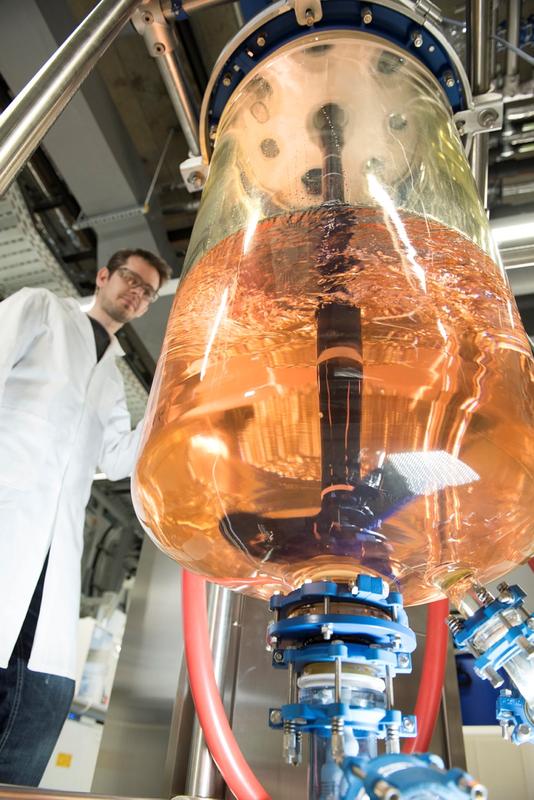Open access infrastructure for a pilot line of nano particle and nano-composites

Stirring reactor (100 liter) for upscaling of laboratory syntheses, equipped with in-situ analysis for particle size measurement to monitor and control processes. K. Dobberke for Fraunhofer ISC
A simple and open access to high-class infrastructure for the reliable production of small batches of functionalized nanoparticles and nanocomposites for testing could ease the way towards new nano-based products for chemical and pharmaceutical companies.
The European Union has allocated funds for the construction of a number of pilot lines and open-access infrastructure within the framework of the EU project CoPilot. A consortium of 13 partners from research and industry, including nanotechnology specialist TNO from the Netherlands and the Fraunhofer Institute for Silicate Research ISC from Wuerzburg, Germany as well as seven nanomaterial manufacturers, is currently setting up the pilot line in Wuerzburg.
First, they establish the particle production, modification and compounding on pilot scale based on four different model systems. The approach enables maximum variability and flexibility for the pilot production of various particle systems and composites. Two further open access lines will be established at TNO in Eindhoven and at the Sueddeutsche Kunststoffzentrum SKZ in Selb.
The “nanoparticle kitchen”
Essential elements of the pilot line in Wuerzburg are the particle synthesis in batches up to 100 liters, modification and separation methods such as semi-continuous operating centrifuge and in-line analysis and techniques for the uniform and agglomeration free incorporation of nanoparticles into composites.
Dr. Karl Mandel, head of Particle Technology of Fraunhofer ISC, compares the pilot line with a high-tech kitchen: “We provide the top-notch equipment and the star chefs to synthesize a nano menu à la carte as well as nanoparticles according to individual requests. Thus, companies can test their own receipts – or our existing receipts – before they practice their own cooking or set up their nano kitchen.”
In the future, the EU project offers companies a contact point if they want to try their nano idea and require enough material for sampling and estimation of future production costs. This can, on the one hand, minimize the development risk, on the other hand, it maximizes the flexibility and production safety. To give lots of companies the opportunity to influence direction and structure/formation/setup of the nanoparticle kitchen, the project partners will offer open meetings on a regular basis.
The next workshop in this context takes place at Fraunhofer ISC in Wuerzburg, 7h July 2016. The partners present the pilot line and the first results of the four model systems – double layered hydroxide nanoparticle polymer composites for flame inhibiting fillers, titanium dioxide nanoparticles for high refractive index composites, magnetic particles for innovative catalysts and hollow silica composites for anti-glare coatings. Interested companies can find more information about the upcoming workshop on the website of the project www.h2020copilot.eu and on the website of Fraunhofer ISC www.isc.fraunhofer.de that hosts the event.
This project has received funding from the European Union’s Horizon 2020 research and innovation program under grant agreement No 645993.
Media Contact
All latest news from the category: Materials Sciences
Materials management deals with the research, development, manufacturing and processing of raw and industrial materials. Key aspects here are biological and medical issues, which play an increasingly important role in this field.
innovations-report offers in-depth articles related to the development and application of materials and the structure and properties of new materials.
Newest articles

First-of-its-kind study uses remote sensing to monitor plastic debris in rivers and lakes
Remote sensing creates a cost-effective solution to monitoring plastic pollution. A first-of-its-kind study from researchers at the University of Minnesota Twin Cities shows how remote sensing can help monitor and…

Laser-based artificial neuron mimics nerve cell functions at lightning speed
With a processing speed a billion times faster than nature, chip-based laser neuron could help advance AI tasks such as pattern recognition and sequence prediction. Researchers have developed a laser-based…

Optimising the processing of plastic waste
Just one look in the yellow bin reveals a colourful jumble of different types of plastic. However, the purer and more uniform plastic waste is, the easier it is to…



